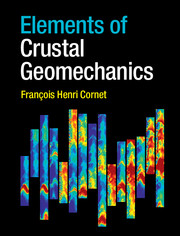Book contents
- Frontmatter
- Epigraph
- Contents
- Preface
- 1 Geomaterials and crustal geomechanics
- 2 Elements of rheology
- 3 Forces and stresses
- 4 Elements of kinematics
- 5 Elements of linear elasticity
- 6 From continuum mechanics to fluid mechanics
- 7 Elements of linear fracture mechanics
- 8 Laboratory investigations on geomaterials under compression 183
- 9 Homogenized geomaterials
- 10 Fractures and faults
- 11 Elements of seismology
- 12 Elements of solid–fluid interactions
- 13 Methods for stress field evaluation from in situ observations
- 14 Elements of stress fields and crustal rheology
- Appendix Elements of tensors in rectangular coordinates
- References
- Index
8 - Laboratory investigations on geomaterials under compression 183
Published online by Cambridge University Press: 05 April 2015
- Frontmatter
- Epigraph
- Contents
- Preface
- 1 Geomaterials and crustal geomechanics
- 2 Elements of rheology
- 3 Forces and stresses
- 4 Elements of kinematics
- 5 Elements of linear elasticity
- 6 From continuum mechanics to fluid mechanics
- 7 Elements of linear fracture mechanics
- 8 Laboratory investigations on geomaterials under compression 183
- 9 Homogenized geomaterials
- 10 Fractures and faults
- 11 Elements of seismology
- 12 Elements of solid–fluid interactions
- 13 Methods for stress field evaluation from in situ observations
- 14 Elements of stress fields and crustal rheology
- Appendix Elements of tensors in rectangular coordinates
- References
- Index
Summary
In chapter 1 we pointed out that a geomaterial is often a mixture of various constituents, which could be rock, soil, liquid or gas. We indicated that the definition of an equivalent continuous geomaterial implies the existence of a representative elementary volume (REV), the properties of which are assumed to be uniform throughout the volume occupied by this equivalent continuum. This implies that the volume of the body for which an equivalent geomaterial is being defined should be orders of magnitudes larger than the REV.
We also observed that rock masses always involve fracture and fault systems that exhibit fractal dimensions, so that some geomechanical properties of rock masses cannot be analyzed with the sole concept of an equivalent geomaterial. For rock masses it is often necessary to define, independently, equivalent geomaterials, equivalent fracture fields and equivalent faults.
Laboratory experimentation is typically intended to address issues related to the properties of geomaterials. It may pursue very diverse goals, whether this involves investigating a particular deformation mechanism or measuring the mechanical characteristics of an equivalent geomaterial. In the latter case the size of the tested volume must be considerably larger than that of the REV.
Experimental work on the mechanical behavior of geomaterials loaded in compression has been conducted in the laboratory for more than a century. For example, work by von Karman (1911) on limestone addressed issues related to rock plasticity whilst that by van Terzaghi (1923, 1943) investigated the plastic behavior of soils with particular attention to the role of pore pressure.
We adopt here the classical distinction between rock and soil, i.e. rocks exhibit some cohesion because of bonds that exist between their constitutive elements, whilst soils are granular materials without cement between the grains. In both rocks and soils the various constitutive elements are much smaller than the REV.
- Type
- Chapter
- Information
- Elements of Crustal Geomechanics , pp. 183 - 217Publisher: Cambridge University PressPrint publication year: 2015



